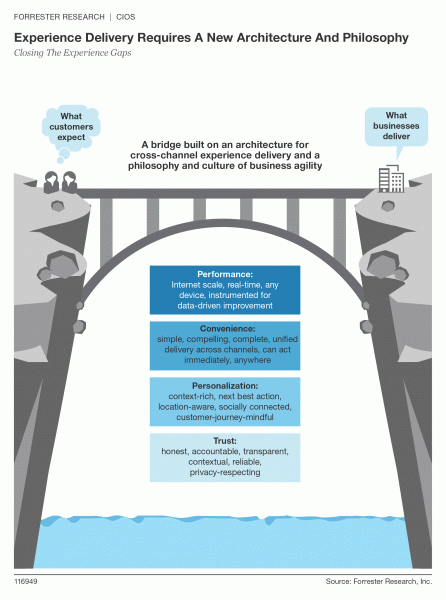Closing The Experience Gaps Requires A New Technology Architecture And Philosophy
Forrester’s Customer Experience Index (CXi) research reveals a shocking business result: Over five years, CXi leaders outperformed the S&P with 43% stock growth, while CXi laggards had negative returns of -34%. (See this Forrester report to learn about our new customer experience index.)
As a result, firms are in an arms race to mobilize their services, deliver new digital capabilities, and delight customers on every step of their journey. eBusiness, marketing, and customer experience teams are eagerly adopting new software to deliver these digital experiences. At times, they chose a conscious uncoupling from the CIO’s team in order to move quickly and stay ahead of customers’ expectations.
Unfortunately, the mismatch of customer-facing teams scrambling to build new digital services while CIOs and their teams hunker down to cut cost and risk has caused a disconnect on the role of technology management in delivering great experiences. In a new Forrester report, Closing The Experience Gaps, my colleague John C. McCarthy and I interviewed more than 35 companies and analyzed survey results from 3,502 US consumers, we uncovered this misalignment and identified the four experience gaps that result (see Figure 1).
Figure 1 Experience Delivery Requires A New Architecture And Philosophy

Experience Delivery Requires A New Architecture And Philosophy
To close the customer experience gaps in performance, convenience, personalization, and trust, firms must think differently and invest differently in the technology of experience delivery. In companies as diverse as Barclays, China Eastern Airlines, Citigroup, General Electric (GE), Nordstrom, Starbucks, and UPS, software technology has become a central pillar in the corporate strategy and brand. We believe that it's time for firms to move beyond point customer solutions and instead take a more sophisticated and scalable two-pronged approach to deliver effective, easy, and emotional customer experiences:
1. An architecture for cross-channel experience delivery. Invest in a new collection of software capabilities, upgrade the aging web and commerce platforms, and build APIs to systems of record in order to deliver at Internet scale on any device in any channel.
2. A philosophy and culture of business agility. Build common ground between business stakeholders, developers, and technology professionals with a shared approach to Agile development and technical engineering focused on delivering great customer experiences.
We’ll describe these two investments and the role of the CIO organization in future posts.
